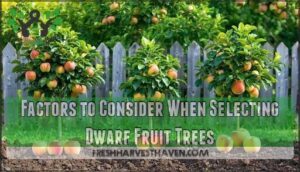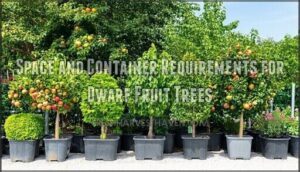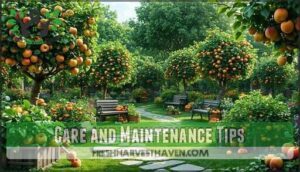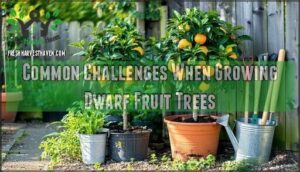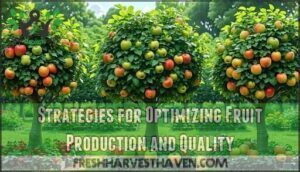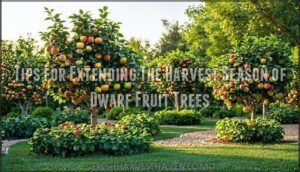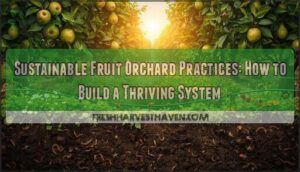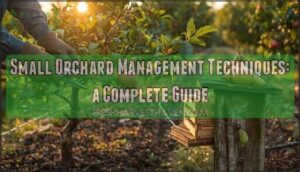This site is supported by our readers. We may earn a commission, at no cost to you, if you purchase through links.
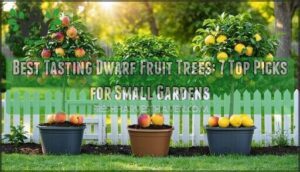
Top varieties like dwarf Honeycrisp apples, Elberta peaches, and Meyer lemons deliver full-sized fruit on trees that stay under 8 feet tall.
These grafted varieties maintain the same delicious taste as their full-sized counterparts while requiring just 6-8 feet of growing space.
Climate considerations matter—citrus thrives in zones 9-11, while stone fruits prefer zones 5-8.
The secret lies in selecting varieties bred specifically for flavor intensity rather than commercial shipping durability, ensuring your harvest rivals anything from the grocery store, with a focus on compact size and full-sized fruit.
Table Of Contents
Key Takeaways
- You’ll get full-sized, flavorful fruit from trees that stay under 8-10 feet tall, making them perfect for small gardens, patios, and containers without sacrificing taste quality.
- You can choose from top varieties like dwarf Honeycrisp apples, Meyer lemons, and Bing cherries that’ll produce fruit within 2-3 years and deliver exceptional flavor that rivals grocery store options.
- You’ll need to match varieties to your USDA hardiness zone – citrus thrives in zones 9-11 while stone fruits prefer zones 5-8 – and provide proper care including full sun, well-draining soil, and regular watering.
- You can extend your harvest season by planting early, mid-season, and late-maturing cultivars of the same fruit type, giving you fresh homegrown produce for months instead of just a few weeks.
Dwarf Fruit Tree Basics
Dwarf fruit trees pack full-sized flavor into compact packages that stay under 10 feet tall, making them perfect for small gardens, patios, and even large containers.
Maximize your harvest in minimal space with dwarf fruit trees that deliver full-sized flavor without the footprint.
You’ll get the same delicious fruit as standard trees while saving precious space and enjoying easier harvesting at eye level, with compact packages.
Characteristics of Dwarf Fruit Trees
Understanding dwarf fruit trees starts with recognizing their key characteristics.
These compact fruit trees typically reach maximum heights of 8-10 feet, making them perfect for small spaces.
Despite their reduced tree height, they produce full-sized fruit with vibrant fruit color and excellent taste.
Most dwarf citrus trees and other small fruit trees feature dense leaf type patterns and concentrated harvest time periods, allowing you to enjoy fresh fruit without the sprawling footprint of standard varieties.
To maximize yields, gardeners must consider proper growing conditions when selecting and caring for their dwarf fruit trees.
Growing Conditions for Dwarf Fruit Trees
Dwarf fruit trees thrive in full sun with six to eight hours of daily exposure.
Well-draining soil with pH 6.0-7.0 promotes healthy growth.
Most varieties need USDA Hardiness Zones 4-9, though citrus requires warmer zones 9-11.
Regular watering keeps soil moist but not waterlogged.
Container growing offers temperature and humidity control for sensitive varieties, which is crucial for healthy trees to flourish.
Choosing Dwarf Fruit Trees
Selecting the right dwarf fruit tree requires careful consideration of your local climate, available space, and taste preferences.
You’ll need to match varieties to your USDA hardiness zone and determine whether you have adequate room for container growing or small garden planting.
Factors to Consider When Selecting Dwarf Fruit Trees
When choosing the right dwarf fruit trees for your garden, consider tree size and rootstock selection carefully.
Most compact tree varieties reach 8-10 feet, but rootstock affects final dimensions and fruit yield.
Evaluate your soil type – well-drained loam works best, while clay needs amendments.
Self-pollinating fruit tree varieties simplify selection, though cross-pollinating types often produce better harvests when space allows.
Understanding dwarf tree characteristics is essential for making informed decisions about your small garden and selecting the right trees based on rootstock selection.
Climate and Hardiness Zones for Dwarf Fruit Trees
Success in growing dwarf fruit trees starts with matching varieties to your USDA Hardiness Zones.
Most dwarf apples thrive in zones 4-8, while citrus like Meyer lemons need zones 8-11.
Temperature ranges matter—deciduous trees require 400-700 chill hours below 45°F for proper fruiting.
Regional planting considerations include soil conditions and local microclimates that affect survival.
For ideal growth, consider dwarf tree care techniques customized to specific varieties.
Space and Container Requirements for Dwarf Fruit Trees
Proper spacing guarantees healthy dwarf fruit trees in small space gardening.
Plant dwarf fruit trees 6-8 feet apart for adequate airflow and disease prevention.
Container gardening requires 20-30 gallon pots with proper drainage systems.
Soil depth should reach 3-5 feet for ideal root development.
Choose sturdy pot material to support mature patio fruit trees and enable seasonal mobility for compact trees, ensuring the overall health of your small space gardening.
Top 7 Best Tasting Dwarf Fruit Trees
You’ll discover that the best tasting dwarf fruit trees combine exceptional flavor with compact growth perfect for small spaces.
These seven varieties offer everything from sweet citrus to juicy stone fruits, all while staying under 10 feet tall.
1. Dwarf Bonsai Fruit Tree Seeds
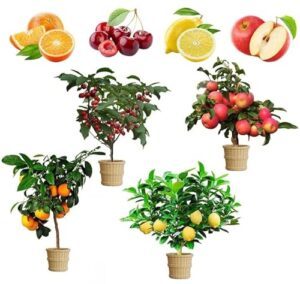
Growing from seed brings the satisfaction of nurturing your fruit tree from day one.
These dwarf bonsai fruit tree seeds include four popular varieties: lemon (Citrus limon), cherry (Prunus subg. Cerasus), orange (Citrus × sinensis), and apple (Malus).
Each packet contains 50 non-GMO, heirloom seeds with high germination rates.
You’ll need patience though—cold stratification for one month mimics winter conditions these seeds require.
Germination takes 14-21 days at 60-80°F.
With proper care, your miniature citrus and apple trees will produce full-flavored fruit in compact containers.
Best For: Plant lovers and bonsai enthusiasts looking to grow their own fruit trees from seed indoors or in small spaces.
- Includes four popular fruit types with high germination rates.
- Non-GMO, heirloom seeds for natural, healthy plants.
- Produces edible, full-flavored fruit in compact containers.
- Germination is slow and requires a full month of cold stratification.
- Some buyers report seeds arrive damaged or fail to sprout.
- Patience and careful seed preparation are needed to succeed.
2. Dwarf Avocado Grafted Tree Plant
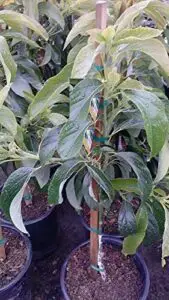
From container patios to urban balconies, the dwarf avocado grafted tree plant (‘Little Cado’) delivers creamy, buttery fruit in a compact 6-10 foot package.
You’ll harvest fresh avocados within 2-3 years, compared to a decade for seed-grown trees.
This self-pollinating variety thrives in USDA zones 9-11 with full sun and well-draining soil.
While yields average fewer fruits than standard trees, the mild, nutty flavor surpasses most store-bought options, making every homegrown avocado worth the wait.
Best For: Home gardeners with limited space, sunny patios, or urban balconies who want compact avocado trees and faster homegrown fruit.
- Yields creamy, fresh avocados within 2–3 years.
- True dwarf size (6–10 ft) is ideal for patios, containers, and small gardens.
- Self-pollinating and easy to maintain in the right climate.
- Lower overall fruit yield compared to full-sized trees.
- Grafted young trees take longer to fruit than established nursery grafts.
- Sensitive to cold; may not survive winter in harsh climates.
3. Washington Navel Orange Fruit Tree
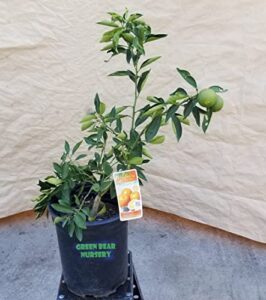
When you’re looking for that perfect citrus punch in a compact package, Washington Navel Orange trees deliver exceptional sweetness.
This semi-dwarf variety reaches 6-10 feet tall and produces seedless, juicy oranges with easy-to-peel skin.
You’ll appreciate the self-pollinating nature—no second tree needed.
These trees thrive in USDA zones 8-11 with full sun and well-draining soil.
The fragrant white blossoms appear in spring, followed by fruit that ripens from late fall through winter.
Container growing works well in colder climates if you bring them indoors during freezing weather to protect the tree, and with proper care, it will continue to provide you with juicy oranges.
Best For: Home growers seeking a compact, easy-care orange tree that produces sweet, seedless fruit and can thrive in small spaces or containers.
- Self-pollinating and produces fruit quickly without the need for another tree.
- Exceptionally sweet, juicy, and seedless oranges that are easy to peel.
- Can be grown in-ground or in containers and kept indoors in colder climates.
- May ship looking different than pictured and some fruit is often removed for shipping.
- Not suitable for harsh winter climates unless brought indoors.
- Needs regular watering and full sun to stay healthy and productive.
4. Dwarf Kiwi Tree Seeds Plant
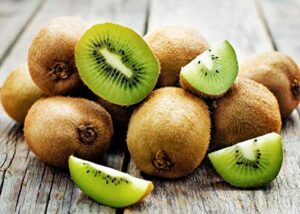
Dwarf kiwi trees (Actinidia arguta) produce sweet, grape-sized fruits that you’ll eat skin and all.
These hardy climbers reach 6-8 feet in containers and thrive in zones 4-9.
You’ll need both male and female plants for fruit production, though self-fertile varieties like ‘Issai‘ exist.
Seeds germinate in 2-4 weeks at 65-75°F and typically fruit within 2-3 years.
The smooth-skinned berries taste sweeter than regular kiwis, with sugar levels reaching 20%.
Plant in well-draining, slightly acidic soil with full sun to partial shade for best results, and enjoy the sweet fruits of your labor, with full sun to partial shade.
Best For: Home gardeners wanting sweet, bite-sized kiwi fruit from compact, easy-care vines suited to small spaces and container growing.
- Naturally sweet, aromatic fruits with smooth, edible skin and high sugar content.
- Compact, vigorous vines thrive in containers or small gardens and are easy to train.
- High germination rates, hardy growth, and resistant to most pests and diseases.
- Most varieties require both male and female plants for fruit production.
- Vines need regular pruning and support to prevent overgrowth.
- Young shoots are sensitive to spring frost and may require protection.
5. Dwarf Everbearing Mulberry Fruit Tree
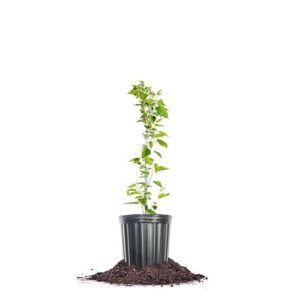
Five varieties of everbearing mulberry trees deliver continuous harvests throughout summer and fall.
You’ll enjoy sweet, blackberry-like berries packed with vitamin C and antioxidants from this compact 2-6 foot tree.
The self-pollinating variety begins producing fruit within your first year, yielding daily harvests during peak season.
These hardy trees adapt to containers or small gardens, thriving in zones 5-10 with minimal maintenance required.
To guarantee the best growth, consider the importance of proper indoor growing conditions for your dwarf fruit trees.
Best For: Home gardeners seeking a compact, low-maintenance fruit tree with continuous sweet berry harvests, ideal for small spaces or container growing.
- Cannot be shipped to California, Arizona, or Hawaii
- Some customers report occasional issues with plant size or condition on delivery
- Transplants may experience temporary shock or dry soil if not handled carefully
- Continuous harvests of sweet, vitamin-rich berries from early summer through fall
- Compact size fits small gardens or containers, self-pollinating and easy to care for
- Highly resistant to pests and diseases, tolerates a range of climates and conditions
6. dwarf bing cherry tree seeds
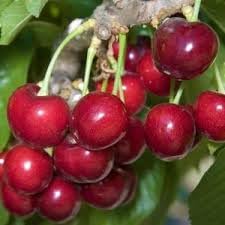
Germinating these cherry seeds requires patience, but the payoff is sweet.
Cold stratification for 10 weeks in your refrigerator mimics winter dormancy and boosts germination success.
You’ll wait 7-10 years for your first harvest, but dwarf Bing cherries produce 50-100 pounds of dark red, juicy fruit annually once established.
Plant two compatible varieties since cross-pollination is essential for fruit set.
These compact trees reach 8-15 feet tall with stunning spring blossoms that attract pollinators to your garden, creating a beautiful display.
Best For: Home gardeners with limited space who want a long-term, rewarding project yielding sweet cherries from a compact, container-friendly tree.
- Produces large, sweet Bing cherries with a rich flavor and stunning spring blossoms.
- Compact size fits patios, decks, and small spaces, offering easy maintenance and harvest.
- Container growing allows better control over soil and growing conditions.
- Requires cold stratification and 7–10 years from seed to fruit-bearing.
- Needs a second compatible cherry variety nearby for successful cross-pollination and fruit set.
- Susceptible to common cherry diseases and potential bird damage to ripening fruit.
7. Dwarf Lemon Bonsai Fruit Tree
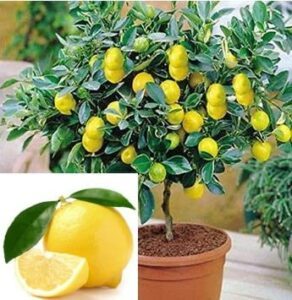
The Citrus limetta Risso delivers surprisingly sweet fruit with minimal acidity, perfect for fresh lemonade and culinary adventures.
This self-fertile beauty reaches just 2-4 feet tall, producing full-sized lemons despite its compact stature. You’ll love the pink-blushed flowers that bloom before yielding juicy, nearly seedless fruit.
The Citrus limetta Risso is cold-hardy and less thorny than typical lemon trees, it thrives in sandy soil with moderate watering. The vigorous growth habit requires regular pruning to maintain its bonsai form while maximizing your harvest.
Best For: Gardeners and indoor plant enthusiasts seeking a compact, self-fertile lemon tree that produces sweet, nearly seedless fruit and doubles as a beautiful ornamental.
- Sweet, low-acid fruit ideal for juicing and cooking.
- Compact size is perfect for indoor or balcony growing.
- Self-fertile and produces attractive, pink-blushed flowers.
- Requires at least 6–8 hours of sunlight daily for healthy fruiting.
- Sensitive to cold and must be moved indoors in cooler climates.
- Needs regular pruning and careful watering to prevent root issues.
Care and Maintenance Tips
Proper care guarantees your dwarf fruit trees produce abundant, flavorful harvests year after year.
Understanding watering schedules, fertilization timing, and pruning techniques will maximize both fruit quality and tree health in your compact growing space, ensuring your dwarf fruit trees receive the best possible care for abundant harvests.
Watering and Fertilization Requirements for Dwarf Fruit Trees
Proper watering and fertilizing keep your dwarf fruit trees thriving in small space gardening.
Water scheduling should provide one gallon per square foot of canopy weekly during summer.
Deep, infrequent irrigation methods encourage strong root systems better than shallow watering.
Check soil moisture regularly—overwatering causes yellowing leaves while underwatering reduces fruit quality.
Fertilizer types with balanced 10-10-10 NPK ratios work best for nutrient balance.
Apply organic options like compost in early spring through July for ideal fruit tree care.
Understanding dwarf tree growth is vital for maximizing yields in small gardens.
Pruning and Training Techniques for Dwarf Fruit Trees
Sharp pruning tools and consistent tree training keep your dwarf fruit trees healthy and productive.
You’ll need clean bypass pruners for branch pruning and fruit thinning during late winter dormancy. Remove suckers below dwarf grafting points to maintain tree structure.
Container gardening requires careful attention to central leader training, ensuring proper air circulation.
Strategic fruit tree care through selective pruning maximizes fruit quality while preventing branch breakage from heavy loads. Proper use of bypass pruning techniques is essential for maintaining healthy trees.
Growing Dwarf Fruit Trees Successfully
While dwarf fruit trees offer incredible rewards, you’ll face specific challenges that require targeted solutions to achieve peak harvests.
Success depends on understanding common growing obstacles and implementing proven strategies that maximize both fruit quality and production timing.
Common Challenges When Growing Dwarf Fruit Trees
Growing dwarf fruit trees presents several challenges you’ll need to navigate.
Pest control becomes trickier in small backyards since beneficial insects have less habitat. Soil quality issues arise quickly in containers, leading to nutrient deficiency if you don’t monitor feeding schedules.
Root bound conditions develop faster than expected, requiring frequent repotting.
Climate adaptation proves difficult for tropical varieties like citrus in cooler zones, affecting fruit production and tree health substantially.
Strategies for Optimizing Fruit Production and Quality
Diligent fruit tree care tips boost fruit production and quality in dwarf fruit trees.
Emphasize Fruit Thinning for larger, tastier crops, and master Pollination Methods using compatible cultivars like Malus domestica ‘Gala’ or Prunus avium ‘Stella’.
Focus on Soil Conditioning with balanced compost, vigilant Pest Management, and strategic Crop Rotation.
Regular pruning and precise fruit tree pollination keep each harvest robust and flavorsome.
Understanding proper dwarf tree care is essential for maximizing the health and productivity of these trees.
Tips for Extending The Harvest Season of Dwarf Fruit Trees
Several strategies can effectively extend your dwarf fruit trees’ harvest season throughout the growing period.
Smart varietal selection and proper timing create longer fruit availability windows.
- Plant early, mid-season, and late-maturing cultivars – Different varieties ripen weeks apart, stretching harvest timing up to two months
- Use heat reflectors and microclimates – South-facing walls and reflective mulch accelerate ripening for staggered crop rotation
- Apply protective coverings – Frost blankets extend late harvests by protecting developing fruit from early freezes
- Practice strategic pruning – Early spring pruning accelerates harvest while summer pruning prolongs fruit development for extended fruit storage
By implementing techniques for season extension methods, gardeners can enjoy a longer harvest period and increased yields from their dwarf fruit trees.
Frequently Asked Questions (FAQs)
What is the best dwarf fruit tree?
You’ll find Meyer lemon (Citrus × meyeri) delivers exceptional sweet-tart flavor that’s perfect for containers. This compact citrus produces aromatic blossoms and versatile fruit year-round in sunny locations.
What is the disadvantage of a dwarf fruit tree?
Dwarf fruit trees produce smaller yields than full-sized trees, limiting your harvest despite their convenience. You’ll also face shorter lifespans and potentially higher maintenance needs for maximum fruit production.
What kind of fruit trees stay small?
Fruit trees that stay small include dwarf varieties of apples, pears, cherries, citrus, peaches, plums, and figs.
You’ll find these compact trees reach only 6-10 feet tall while producing full-sized, delicious fruit perfect for small yards.
How long before dwarf trees produce edible fruit?
Good things come to those who wait!
Dwarf fruit trees typically bear edible fruit within 2-3 years after planting, though citrus varieties like Meyer lemons may take 3-4 years to produce their first harvest.
Which dwarf varieties have the longest shelf life?
Apples like ‘Granny Smith’ and pears such as ‘Conference’ offer exceptional storage longevity, lasting months when properly refrigerated.
You’ll find citrus varieties including Meyer lemons and Washington navels also maintain quality for extended periods compared to stone fruits.
Conclusion
Growing the best tasting dwarf fruit trees transforms limited garden space into productive orchards.
You’ll discover these compact cultivars deliver exceptional flavor while fitting containers and small yards perfectly.
Success depends on matching varieties to your hardiness zone and providing consistent care.
With proper selection and maintenance, you’ll harvest premium fruit from trees under eight feet tall, proving that size doesn’t compromise taste quality in home gardening.
- https://www.starkbros.com/growing-guide/article/dwarf-fruit-trees
- https://happilyhomegrown.com/5-tips-for-selecting-fruit-trees/
- https://www.mehrabyannursery.com/growing-guide/fruit-trees/how-to-select-fruit-trees/
- https://www.southernliving.com/garden/trees/dwarf-fruit-trees
- https://ccenassau.org/resources/trees-dwarf-fruit

